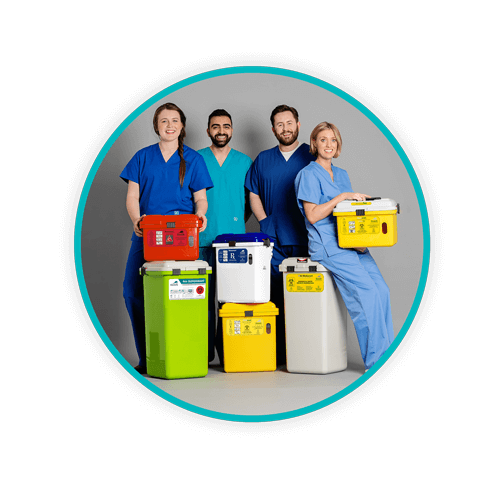What is Considered Hazardous Waste in the Dental Office?

Healthcare waste from dental offices throughout Canada should be dealt with much like any other medical waste stream, especially as it relates to identifying and segregating between non-hazardous and hazardous waste. Waste from dental offices can contain a variety of streams, including pathological, biomedical, heavy metal, and chemical waste. Dental practitioners are responsible for providing adequate training for staff to recognize waste categories and biomedical versus “regular” disposable waste in a dental facility.
Best practices for dental facilities are encouraged, and there are numerous regulations for dental waste collection, storage, and disposal. Moreover, every dental provider and waste generator must follow local requirements as well as provincial and federal regulatory guidelines to avoid fines and penalties.
Last but not least, proper management of dental waste, including hazardous dental waste, reduces the risk of contamination through exposure to people and protection of the environment.
TOPICS WE WILL COVER:
1 / What agencies make the laws?
2 / Identification of hazardous dental waste
5 / Dental wastes containing lead
6 / A word about pathological waste
7 / Turn to Daniels Health Canada for healthcare waste management
What agencies make the laws?
Several agencies and associations throughout Canada devise regulations and laws that guide healthcare providers in compliant and safe management and disposal of healthcare waste, including dental providers. The Canadian government, provincial dental associations, the Canadian Standards Association, the Canadian Dental Association, and the Canadian Council of Ministers of the Environment all contribute guidance to the treatment, handling, and disposal of non-hazardous and hazardous waste generated from a dental office.
Identification of hazardous dental waste
What exactly is hazardous waste in dental settings? Dental wastes that are identified and classified as hazardous include:
- Wastes containing mercury, such as scrap amalgam and elemental mercury
- Wastes containing silver, such as x-ray films, x-ray fixers, and/or developers
- Wastes containing lead, including lead aprons and lead foil packets
- Anatomical biomedical waste
- Sterilizing agents, various chemicals, or disinfectants used within a dental facility
Mercury amalgam
The Canadian Environmental Protection Act of 1999 identifies mercury as a toxic substance. In the past, mercury dental amalgam fillings were known as “silver fillings.” Such amalgam contains equal mixtures of alloy powders and elemental mercury. Alloy powders could contain metals such as zinc, silver, tin, and copper. The mercury was used to bind the compounds together to create a stable material used to fill cavities.
Dental amalgam fillings containing mercury are still used in countries around the world although mercury has been identified as a toxin that can pose threats to not only health, but to the environment. As of 2005, the World Health Organization warned about its harmful effects on numerous body systems. In 2017, the United Nations Environment Programme began phasing out the use of mercury in dental amalgam.
Canadian-wide standards and best management practices also recommend reduction in dental amalgam mercury waste discharges. While the Canadian Dental Association believes that dental amalgam is a safe and effective restorative filling material, it too has sought to reduce or completely eliminate any adverse effects of mercury on the environment by phasing down the use of such dental amalgam.[1]
Dental amalgam containing mercury has already been phased out in some countries. For example, In the United States, the Environmental Protection Agency (EPA) developed standards for use of amalgam separators and dental clinics per the Clean Water Act to restrict dental mercury from being flushed down chair-side drains and into the environment. Those standards went into effect in 2017.[2]
Amalgam separators are now commonly used throughout Canada to meet or exceed ISO Standard 11143. Such separators have been used for years, designed to prevent waste amalgam from going down drains and potentially leaching into the environment.
Throughout Canada, dentists don’t typically install amalgam fillings anymore, but some do replace the older silver fillings. Dental providers are required to understand how to handle the older filling substance, known as contact amalgam, meaning that it has come into contact with the patient’s mouth.
Non-contact amalgam is to be separated from contact amalgam prior to disposal. Non-contact amalgam (which has not been in contact with the patient) is to be placed in an airtight and break-resistant container and labelled “Non-contact amalgam.”
Wastes containing silver
Other hazardous dental wastes are those that contain silver (such as fixer solutions), depending on its concentration. Every province defines their own regulations regarding concentration limits.
According to the best management practices, fixer and developer solutions are typically acidic in nature, and so the disposal regulations for disposal in sewers will be subject to the bylaws of the municipality or province in regard to pH levels. However, such wastes should not be released into a common waste stream such as the sewage system. Rather, this waste is to be contained in a compliant waste container and disposed of by an approved waste carrier for disposal or recycling.[3]
X-ray film, whether developed or undeveloped, may also contain metals such as lead or silver, which are commonly listed as environmental contaminants. It is not to be disposed of in any common waste stream such as regular trash or sewage systems. Unused film can be recycled. Developed film should also be recycled or can be disposed of in “regular” garbage.
Dental wastes containing lead
Dental wastes that contain lead can contaminate groundwater and soil if disposed in landfills. As with silver content, concentration of lead content limits will be determined by municipal bylaws. As such, any lead waste should not be disposed of in a common waste stream such as a sewage system or regular garbage. Lead aprons and lead packets should be properly transported off-site and disposed of by an approved waste transport company based on guidelines of the province or territory, and not in general waste streams.
A word about pathological waste
In a dental care environment, a dental practice might generate some biomedical waste that can include blood-soaked gauze or other materials, small pieces of human tissue, and discarded sharps. A number of wastes that are typically found in a dental facility are not classified as a biomedical waste but only as long as the dental practice ascertains that that waste “does not release liquid or semi-liquid blood or blood products if compressed.” Those items include:
- Gauze
- Extracted teeth
- Materials soaked with saliva
- Surgical or examination gloves
Even so, biomedical wastes are to be appropriately colour-coded and marked with a universal biohazard symbol. Any blood-soaked material should be separated from sharps or other anatomical biomedical waste. Blood-soaked materials are to be placed into a yellow liner or container marked with the biohazard symbol. Sharps are to be placed in an appropriate and compliant sharps container that is puncture and leak-proof, and appropriately coloured and labelled as biohazard waste.
Turn to Daniels Health Canada for healthcare waste management
Daniels Health Canada encourages compliance with Canadian laws and regulations regarding hazardous dental waste. Reducing environmental dangers to the environment as well as the volume of waste ending up in landfills is our goal. We provide a number of disposal processes that ensure not only such protection, but safety to human health as well. For more information about resources, products, or services that we provide to dental professionals, contact one of our knowledgeable representatives today.
Let's Talk!
Your time is valuable, and we don’t want to play hard to get. You can either phone us directly on the details listed on our contact page, or feel free to fill out this short form and one of our team members will get back to you as quickly as possible.
